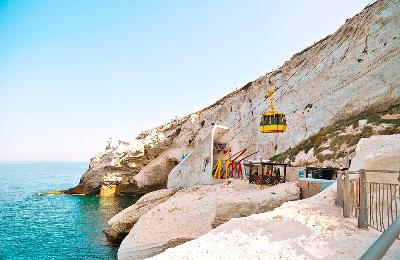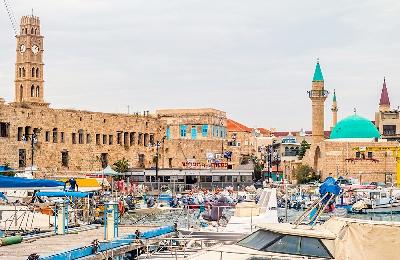
16. Haifa. Acco. Rosh-A-Nicra Reserve Promotion
We also found excursions from other cities that are close to your departure city
Other excursions that also deserve your attention
Rosh HaNikra, located on the northernmost coastal point of Israel along the border with Lebanon, is a geographical wonder that stands as one of Israel's most visited natural attractions. This site, characterized by its white chalk cliffs facing the Mediterranean Sea, holds a network of spectacular grottoes shaped by the relentless pounding of the waves over thousands of years. Rosh HaNikra is not just a testament to nature's artistic force but also a place rich in historical narratives, adding layers of human intrigue to its natural beauty.
**The Natural Marvel of the Grottoes**
The grottoes of Rosh HaNikra are a dynamic system of cavernous tunnels and sea caves formed by the action of the sea on the soft chalk rock. The geological processes leading to their creation have been ongoing for thousands of years. The caverns, with their undulating walls, reflect the sea's rhythmic yet forceful impact, creating a labyrinth of channels where the water's ebb and flow continue to shape their dimensions.
Visitors to the grottoes are treated to a stunning palette of colors, from the azure blues of the Mediterranean waters to the stark white of the cliffs, often contrasted by the deep aquamarine hues within the caves themselves. This visual spectacle is accompanied by the symphony of waves echoing through the caverns, creating an immersive natural experience.
One of the most remarkable aspects of the grottoes is how they are accessed. A steep cable car descent, known to be one of the steepest in the world, takes visitors from the cliffs above directly down to the grottoes, offering a breathtaking panoramic view of the surrounding seascape and geological formations.
**Historical Footprints: From Ancient Times to Modern History**
Rosh HaNikra has seen the passage of various civilizations, each leaving its mark and weaving a rich historical tapestry. Historically, the location was known and utilized for its natural harbor, serving various traders and armies. It was a known passage used by the armies of the Egyptian Pharaohs, and Alexander the Great once passed through this region during his conquests.
One of the most significant human imprints at Rosh HaNikra is the man-made tunnel created by the British during the Second World War. In an ambitious engineering endeavor, they blasted through the solid rock to create a railway tunnel as part of a supply route that extended from Egypt to Turkey. However, the tunnel was soon abandoned following the end of the British Mandate, and in the wake of Israel's War of Independence, the tracks were removed, leaving behind a historical relic that adds a layer of modern history to the ancient site.
**A Mosaic of Flora and Fauna**
The environment around Rosh HaNikra hosts a diverse range of plant and animal life, enhancing its attraction for nature enthusiasts. The cliffs and surrounding areas are adorned with various species of plants adapted to the Mediterranean climate, providing bursts of color against the white chalk during the blooming season.
The grottoes themselves are home to various aquatic species, with the rock pools hosting a microcosm of marine life. Bird watchers also find Rosh HaNikra fascinating, as the cliffs serve as vantage points to observe migratory birds during different seasons.
**Cultural Significance and Modern Symbolism**
Over the years, Rosh HaNikra has transcended its identity as just a natural site, embedding itself into Israeli culture and consciousness. It has become a symbol of natural beauty, resilience, and the historical continuity of the land. The site has inspired artists, writers, and filmmakers, capturing the imagination with its dramatic landscapes and the somewhat mystical allure of its grottoes.
Rosh HaNikra is often featured in promotional materials for tourism, representing Israel's diverse natural attractions. Furthermore, it's a favored location for events, particularly weddings and other celebrations, due to its romantic scenery.
**The Border Perspective**
The unique location of Rosh HaNikra, right on the border with Lebanon, adds a poignant dimension to its narrative. From certain points on the cliffs, visitors can view the border, marked by fences and military installations, providing a stark reminder of the ongoing tensions within the region.
This proximity to the border has, in history, made Rosh HaNikra a strategic point during various military operations, including during the British Mandate period and the subsequent conflicts involving Israel and Lebanon. For visitors, this aspect of Rosh HaNikra provides food for thought on the complexities of human conflicts juxtaposed with the site's serene natural beauty.
**Educational and Recreational Activities**
Rosh HaNikra is more than a visual treat; it's an educational experience. The visitors' center provides insightful information about the site's geological and historical aspects. There are guided tours that take visitors through the grottoes while providing commentary on the site's formation, ecology, and significance in human history.
For recreational enthusiasts, the surrounding areas of Rosh HaNikra offer hiking trails and cycling paths. These trails are particularly popular during the spring, when the weather is mild, and the local flora is in bloom.
**A Symbol of Nature's Persistence**
In the grander narrative, Rosh HaNikra stands as a symbol of nature's enduring force in a region characterized by its turbulent history.







